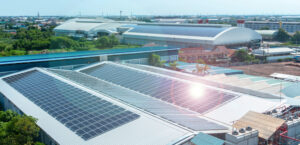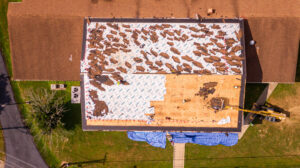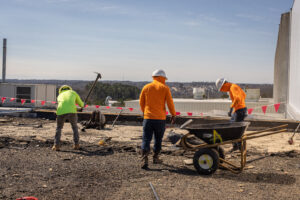There is much talk these days about green roofs. It’s easy to see why they are becoming so popular not only in residential buildings but also in commercial ones. Adding a vegetative layer to the roof of your commercial building can provide several advantages, such as reducing energy costs, increasing biodiversity, and providing an aesthetically pleasing exterior. However, there are potential drawbacks associated with green roofs that should also be considered. In this article, we will outline the pros and cons of adding a vegetative layer to your commercial building’s roof.
What Is a Green Roof and Why Commercial Buildings Should Consider It
When you hear the phrase green roof, it may conjure up images of lush plants perched atop a tall office building. A green roof, known as a vegetative roof or eco-roof, is the roof of a building that is wholly or partially covered with vegetation grown in either module (trays) or mats.
Green roofs are one of the most innovative sustainable solutions to the current environmental dilemmas that the world faces. By applying green roof technology, architects and commercial roofers can alleviate some of the issues associated with urbanization, such as the urban heat island effect, loss of green space, and generation of greenhouse gases.
They can improve energy efficiency through insulation, improve air quality thanks to vegetation filtering airborne pollutants, reduce stormwater runoff, and reduce noise. Moreover, green roofs provide green space to cities, allowing them to become more livable by reintroducing nature back into the cityscape while helping green infrastructure become more resilient over time due to water retention provided by plants on the green roof surface.
Green roofs are the perfect tool for commercial building owners to generate resiliency and long-term savings while reducing their carbon footprint.
Types of Green Roofs
Modular Systems and Built-in-Place Systems:
Modular systems consist of plantings grown in trays, then placed on top of the waterproofing layer and covered with a drainage layer. Built-in-place green roofs require more work as they involve excavating soil and constructing raised beds to contain plants on the roof.
In both cases, an irrigation system is necessary to ensure that the plants have access to adequate water and nutrients.
Extensive, Intensive, and Semi-Intensive Systems:
Extensive green roofs are the most basic type of green roof system, consisting of plants in shallow growing media with low maintenance needs. These green roofs require little irrigation because the shallow growing media dries quickly in sunny weather and features drought-tolerant plant species.
Intensive green roof systems are slightly more complex. They feature large planters filled with soil instead of a shallow layer of growing medium on top of the waterproof membrane or exterior deck. A variety of plants makes these green roof systems especially attractive while providing considerable shade during warm weather.
Finally, semi-intensive green roof systems are a hybrid between extensive and intensive green roof systems in terms of function and appearance. They combine numerous plants with more significant amounts of soil for deeper rooting and decorative features such as sculptures or works of art.
The Benefits of Adding a Vegetative Layer to Your Roof
Insulation
One of the primary benefits of adding a vegetative layer to your roof is that it can help to insulate your building. Green roofs can help improve a roof’s thermal performance by providing an additional layer of insulation. This can help reduce energy costs in the summer by keeping the building more relaxed and preventing heat from escaping in the winter.
Stormwater Management
Another benefit of a vegetative roof is that it can help to manage stormwater runoff. When rain falls on a commercial roof, it runs off and can pick up pollutants such as oil, grease, and heavy metals. This runoff then flows into storm drains and eventually into waterways, where it can cause pollution. In addition to reducing stormwater runoff, flooding, and soil erosion, a vegetative roof can also help reduce pollution and recharge groundwater aquifers.
Extended Roof Life
A vegetative roof can also help to extend the life of your roof. Plants protect the roof membrane from ultraviolet (UV) rays, wind, and hail damage. This protection can help extend your roof’s life up to two times. Vegetative roofs are relatively easy to maintain and only require occasional watering and trimming. They are also low-maintenance compared to traditional roofs, which require regular cleaning and repair.
Reduced Noise Pollution
Vegetative roofs can also help to reduce noise pollution. Plants absorb sound waves, which reduces the amount of noise that enters your commercial buildings. This is especially beneficial if you live in an urban area or near a busy road.
LEED® Certification
Incorporating a vegetative roof into your building can help you achieve LEED® certification. The US Green Building Council awards LEED points for green roofs designed to reduce energy costs and improve indoor environmental quality. This certification can help you gain recognition and create a positive image for your business.
Enhances Workplace Productivity
Not only are vegetative roofs good for the environment, but they can also increase workplace productivity. How? Green spaces have been shown to reduce stress and improve cognitive function. In other words, you improve focus and concentration by making your office more pleasant.
The Drawbacks of Adding a Vegetative Layer to Your Roof
Complexity
Adding a vegetative layer to your roof can be complex and require specialized knowledge. Installation requires understanding waterproofing, drainage, protection from roots, slope considerations, climate factors, loading capacity, and maintenance needs. This complexity also adds cost to the installation process.
Weight Restrictions
A significant concern when incorporating a vegetative roof is the weight of the added layer. Different green roofs can vary significantly in weight, from lightweight options such as sedum mats to much heavier intensive systems. It’s essential to ensure that your roof can support the added weight before beginning any work on your green roof.
Maintenance Costs
Vegetative roofs require regular maintenance to stay healthy and look good. This includes tasks such as trimming, weeding, watering and fertilizing. Depending on the type of system you install, these costs can add up over time and could potentially offset some of the savings from installing a green roof.
The vegetative or green roof has many benefits, but some drawbacks should be considered before making the switch. If you’re thinking of adding a vegetative layer to your building’s roof, contact us for more information about how we can help. We’ll work with you to find the best option for your property and ensure the installation goes as smoothly as possible.






